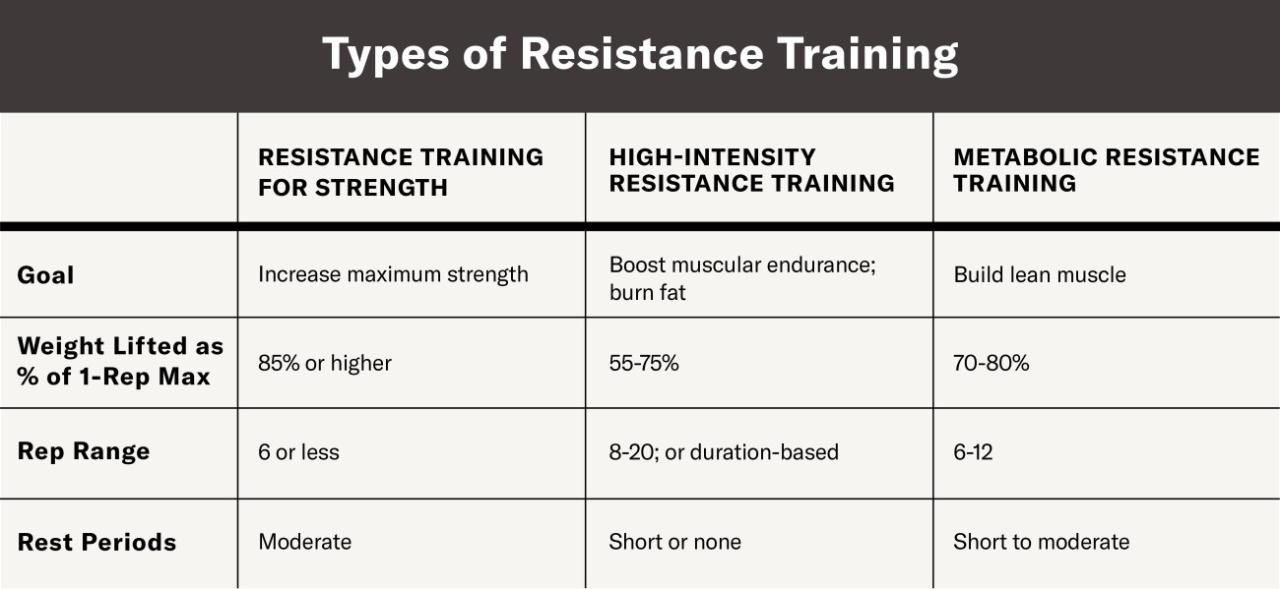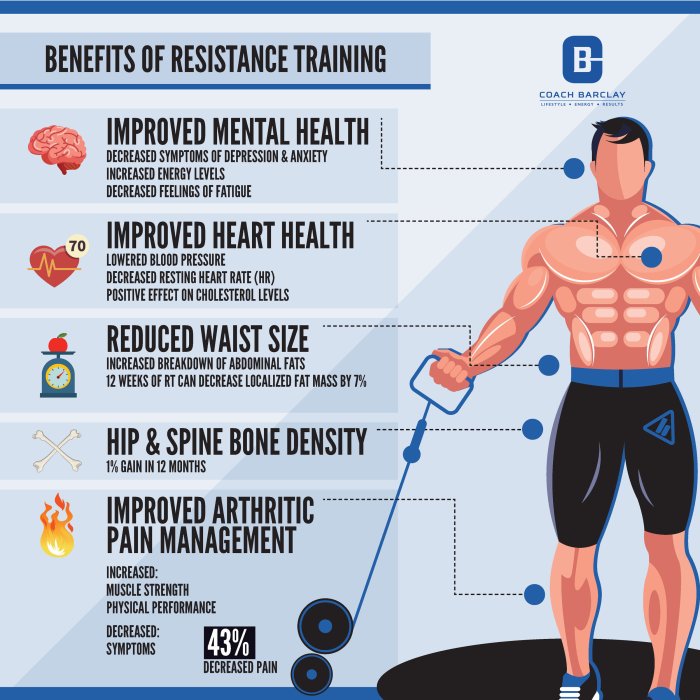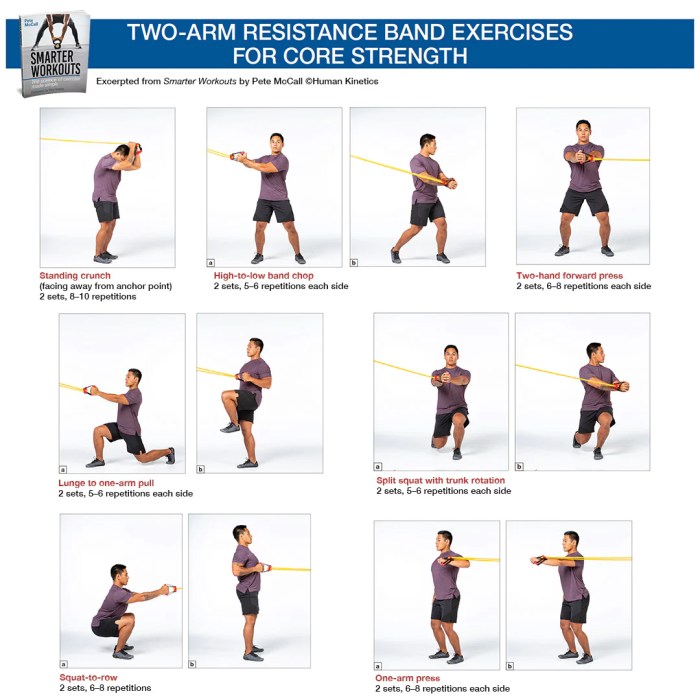Resistance training helps build muscle, lose weight, and improve overall health. It is a form of exercise that involves using weights or other forms of resistance to work against. This type of training can be done at home, in a gym, or even outdoors.
Resistance training is a great way to improve your strength, power, and endurance. It can also help you to lose weight, build muscle, and improve your overall health. If you are new to resistance training, it is important to start slowly and gradually increase the weight or resistance as you get stronger.
Introduction
Resistance training is a type of exercise that involves using resistance to build muscle strength and increase overall fitness. It can be done using a variety of equipment, including bodyweight, free weights, and machines. Resistance training has many benefits, including:
- Increased muscle strength and size
- Improved bone density
- Reduced body fat
- Improved cardiovascular health
- Reduced risk of chronic diseases, such as heart disease, stroke, and type 2 diabetes
There are many different types of resistance training exercises, each of which targets different muscle groups. Some common exercises include:
- Push-ups
- Pull-ups
- Squats
- Lunges
- Deadlifts
- Bench press
- Overhead press
- Barbell row
Resistance training can be done using a variety of equipment, including:
- Bodyweight
- Free weights
- Machines
The type of equipment you use will depend on your fitness level and goals. If you are new to resistance training, it is important to start slowly and gradually increase the amount of weight or resistance you use over time.
It is also important to listen to your body and rest when you need to.
Progressive Overload
Progressive overload is a key principle of resistance training. It means gradually increasing the amount of weight or resistance you use over time. This is important for continued muscle growth and strength gains. If you do not challenge your muscles with increasing resistance, they will not continue to adapt and grow.
Rest and Recovery, Resistance training helps
Rest and recovery are also important for resistance training. Your muscles need time to repair and rebuild after a workout. If you do not get enough rest, you may experience muscle soreness, fatigue, and decreased performance. It is important to listen to your body and rest when you need to.
Muscle Building and Strength
Resistance training plays a crucial role in building muscle mass and enhancing strength. It involves exercising against an external force, such as weights, bands, or bodyweight, to challenge and stimulate muscle growth.
Muscle Building
When you engage in resistance training, you create microscopic tears in your muscle fibers. As your body repairs these tears, it synthesizes new muscle proteins, leading to muscle growth. This process is known as muscle hypertrophy.
To maximize muscle building, it’s essential to:
- Lift heavy weights or perform exercises with high resistance.
- Focus on compound exercises that work multiple muscle groups simultaneously.
- Train each muscle group 2-3 times per week.
- Consume adequate protein to support muscle recovery and growth.
Strength Building
Resistance training also plays a vital role in increasing strength. It helps your muscles generate more force by improving neuromuscular coordination, muscle fiber recruitment, and muscle cross-sectional area.
To enhance strength, it’s important to:
- Gradually increase the weight or resistance over time.
- Focus on exercises that involve the major muscle groups.
- Perform exercises with proper form and technique.
- Allow for sufficient rest and recovery between workouts.
Bone Health
Resistance training is not just about building muscles and strength. It also plays a crucial role in maintaining bone health. As we age, our bones naturally lose density, making them more susceptible to fractures. Resistance training can help counteract this process by increasing bone density and strength.
How Resistance Training Improves Bone Density
When you perform resistance training exercises, you put stress on your bones. This stress stimulates the cells in your bones to produce new bone tissue, increasing bone density and strength.
Exercises for Bone Health
Not all resistance training exercises are created equal when it comes to bone health. Some of the most beneficial exercises include:
- Weightlifting
- Bodyweight exercises (e.g., push-ups, squats)
- Resistance band exercises
- Tai chi
- Dancing
Frequency, Intensity, and Duration
For optimal bone health, aim for at least two to three resistance training sessions per week. Each session should include exercises that target all major muscle groups. The intensity of your workouts should be challenging but not so difficult that you cannot maintain good form.
Start with a weight or resistance level that you can handle for 10-12 repetitions, and gradually increase the weight or resistance as you get stronger.
Nutrition for Bone Health
In addition to resistance training, nutrition plays a vital role in bone health. Calcium and vitamin D are two essential nutrients for bone health. Calcium is the primary mineral in bones, while vitamin D helps your body absorb calcium.
Good sources of calcium include:
- Dairy products (e.g., milk, cheese, yogurt)
- Leafy green vegetables (e.g., kale, spinach)
- Fortified foods (e.g., cereals, juices)
Good sources of vitamin D include:
- Fatty fish (e.g., salmon, tuna)
- Eggs
- Fortified foods (e.g., milk, cereals)
Osteoporosis Prevention
Resistance training can help prevent osteoporosis, a condition characterized by weak and brittle bones. Osteoporosis is a major risk factor for fractures, especially in older adults. By increasing bone density and strength, resistance training can help reduce the risk of fractures and improve overall bone health.
Weight Management
Resistance training is a crucial component of weight management due to its ability to burn calories and promote weight loss. During resistance exercises, your body utilizes energy to lift weights, resulting in a higher calorie expenditure compared to other forms of exercise.
This increased energy expenditure contributes to the creation of a calorie deficit, a fundamental factor in losing weight.
Role in Maintaining a Healthy Weight
Maintaining a healthy weight involves balancing calorie intake and expenditure. Resistance training plays a significant role in this equation by aiding in the maintenance of muscle mass. Muscle tissue has a higher metabolic rate than fat tissue, meaning it burns more calories even at rest.
By preserving muscle mass through resistance training, you can increase your resting metabolic rate, making it easier to maintain a healthy weight over time.
Metabolic Health

Resistance training is not just about building muscles and strength; it also plays a crucial role in improving our overall metabolic health. Let’s explore how resistance training can help us enhance our insulin sensitivity and reduce the risk of chronic diseases.
Insulin Sensitivity
Insulin is a hormone that helps our body use glucose for energy. Resistance training can improve insulin sensitivity, meaning our body becomes more efficient at using insulin to take up glucose from the bloodstream. This is important because it helps regulate blood sugar levels and reduces the risk of developing type 2 diabetes.
Chronic Disease Risk
Chronic diseases such as heart disease, stroke, and type 2 diabetes are often associated with metabolic disorders. Resistance training has been shown to improve metabolic health by reducing inflammation, improving lipid profiles (cholesterol levels), and regulating blood pressure. These effects contribute to a lower risk of developing these chronic diseases.
Mood and Cognitive Function
Resistance training offers a multifaceted approach to enhancing not only physical well-being but also mental health and cognitive function. Engaging in regular resistance exercises has been linked to improvements in mood, a reduction in symptoms of depression, and enhanced cognitive abilities.
Mood Enhancement
Resistance training has been shown to elevate mood and combat symptoms of depression through various mechanisms. Exercise in general triggers the release of endorphins, which possess mood-boosting and pain-relieving effects. Resistance training, specifically, has been found to increase the production of serotonin, a neurotransmitter associated with feelings of happiness and well-being.Moreover, resistance training promotes the growth of new neurons in the hippocampus, a brain region crucial for mood regulation.
This neurogenesis contributes to improved mood and reduced susceptibility to depression.
Injury Prevention: Resistance Training Helps

Resistance training is a powerful tool for injury prevention. By strengthening muscles and connective tissues, it can help stabilize joints, improve balance, and reduce the risk of falls and other injuries.
Some resistance training exercises that are particularly beneficial for injury prevention include:
- Squats:Squats strengthen the muscles of the legs, hips, and core, which can help improve balance and stability.
- Lunges:Lunges target the muscles of the legs, hips, and glutes, which can help improve balance and stability.
- Deadlifts:Deadlifts strengthen the muscles of the back, legs, and core, which can help improve posture and reduce the risk of back injuries.
- Push-ups:Push-ups strengthen the muscles of the chest, shoulders, and triceps, which can help improve posture and reduce the risk of shoulder injuries.
- Rows:Rows strengthen the muscles of the back, shoulders, and arms, which can help improve posture and reduce the risk of back and shoulder injuries.
| Exercise | Benefits | Target Muscle Groups |
|---|---|---|
| Squats | Improves balance and stability | Legs, hips, core |
| Lunges | Improves balance and stability | Legs, hips, glutes |
| Deadlifts | Improves posture and reduces risk of back injuries | Back, legs, core |
| Push-ups | Improves posture and reduces risk of shoulder injuries | Chest, shoulders, triceps |
| Rows | Improves posture and reduces risk of back and shoulder injuries | Back, shoulders, arms |
Sample Resistance Training Program for Injury Prevention
- Warm-up:5-10 minutes of light cardio, such as walking or jogging, followed by dynamic stretching.
- Exercises:Perform 2-3 sets of 10-12 repetitions of each exercise, resting for 1-2 minutes between sets.
- Cool-down:5-10 minutes of static stretching.
Proper Form and Technique
It is important to use proper form and technique when performing resistance training exercises to prevent injuries. This includes using the correct weight, maintaining a neutral spine, and keeping your core engaged.
Warm-up and Cool-down
Warming up before resistance training helps prepare your muscles for exercise and reduces the risk of injuries. Cooling down after resistance training helps reduce muscle soreness and stiffness.
Flexibility and Range of Motion

Resistance training is not just about building muscle and strength; it can also help improve flexibility and range of motion. Flexibility refers to the ability of a muscle to lengthen, while range of motion refers to the degree to which a joint can move.
Resistance training can improve both flexibility and range of motion by:
- Increasing muscle extensibility:Resistance training can help increase the extensibility of muscles by breaking down scar tissue and increasing blood flow to the muscles.
- Improving joint mobility:Resistance training can help improve joint mobility by increasing the production of synovial fluid, which lubricates the joints.
- Strengthening the muscles around the joints:Resistance training can help strengthen the muscles around the joints, which can help stabilize the joints and improve range of motion.
Specific Exercises for Flexibility
Many different resistance training exercises can help improve flexibility. Some of the most effective exercises include:
- Static stretching:Static stretching involves holding a stretch for a period of time, typically 30 seconds or more. This type of stretching can help increase the extensibility of muscles.
- Dynamic stretching:Dynamic stretching involves moving through a range of motion while gradually increasing the intensity. This type of stretching can help improve joint mobility.
- Active isolated stretching:Active isolated stretching is a type of stretching that involves contracting a muscle while simultaneously stretching it. This type of stretching can help improve both flexibility and range of motion.
Optimal Frequency, Intensity, and Duration
The optimal frequency, intensity, and duration of resistance training for flexibility improvement vary depending on the individual’s fitness level and goals. However, general guidelines include:
- Frequency:2-3 times per week
- Intensity:Light to moderate weight
- Duration:10-15 minutes per session
| Finding/Recommendation | Explanation |
|---|---|
| Resistance training can improve flexibility and range of motion. | Resistance training can help increase muscle extensibility, improve joint mobility, and strengthen the muscles around the joints. |
| Static stretching, dynamic stretching, and active isolated stretching are all effective exercises for improving flexibility. | These exercises can help increase muscle extensibility, improve joint mobility, and strengthen the muscles around the joints. |
| The optimal frequency, intensity, and duration of resistance training for flexibility improvement vary depending on the individual’s fitness level and goals. | General guidelines include 2-3 times per week, light to moderate weight, and 10-15 minutes per session. |
Additional Tips and Considerations
- Warm up before stretching:Warming up before stretching can help prevent injuries.
- Stretch slowly and gently:Stretching should be done slowly and gently to avoid injuries.
- Hold stretches for 30 seconds or more:Holding stretches for 30 seconds or more can help increase muscle extensibility.
- Listen to your body:If you feel pain while stretching, stop and consult with a healthcare professional.
Last Word

Resistance training is a safe and effective way to improve your overall health and fitness. If you are looking for a way to get in shape, lose weight, or improve your strength, resistance training is a great option.
FAQs
What are the benefits of resistance training?
Resistance training has many benefits, including:
- Increased muscle mass
- Reduced body fat
- Improved strength
- Enhanced power
- Improved endurance
- Reduced risk of injury
- Improved bone density
- Improved mood
- Reduced risk of chronic diseases
What are some examples of resistance training exercises?
There are many different types of resistance training exercises, including:
- Bodyweight exercises (e.g., push-ups, squats, lunges)
- Free weight exercises (e.g., dumbbell presses, barbell squats, deadlifts)
- Machine exercises (e.g., leg press, chest press, lat pulldown)
How often should I do resistance training?
The frequency of your resistance training workouts will depend on your fitness goals and experience level. However, most experts recommend doing resistance training 2-3 times per week.
How much weight should I lift?
The amount of weight you lift will depend on your strength and fitness level. It is important to start with a weight that is challenging but not too heavy. You should be able to complete 8-12 repetitions of each exercise with good form.
How long should I rest between sets?
The amount of rest you take between sets will depend on the intensity of your workout. For heavy lifting, you may need to rest for 2-3 minutes between sets. For lighter lifting, you may only need to rest for 1-2 minutes.
Leave a Reply